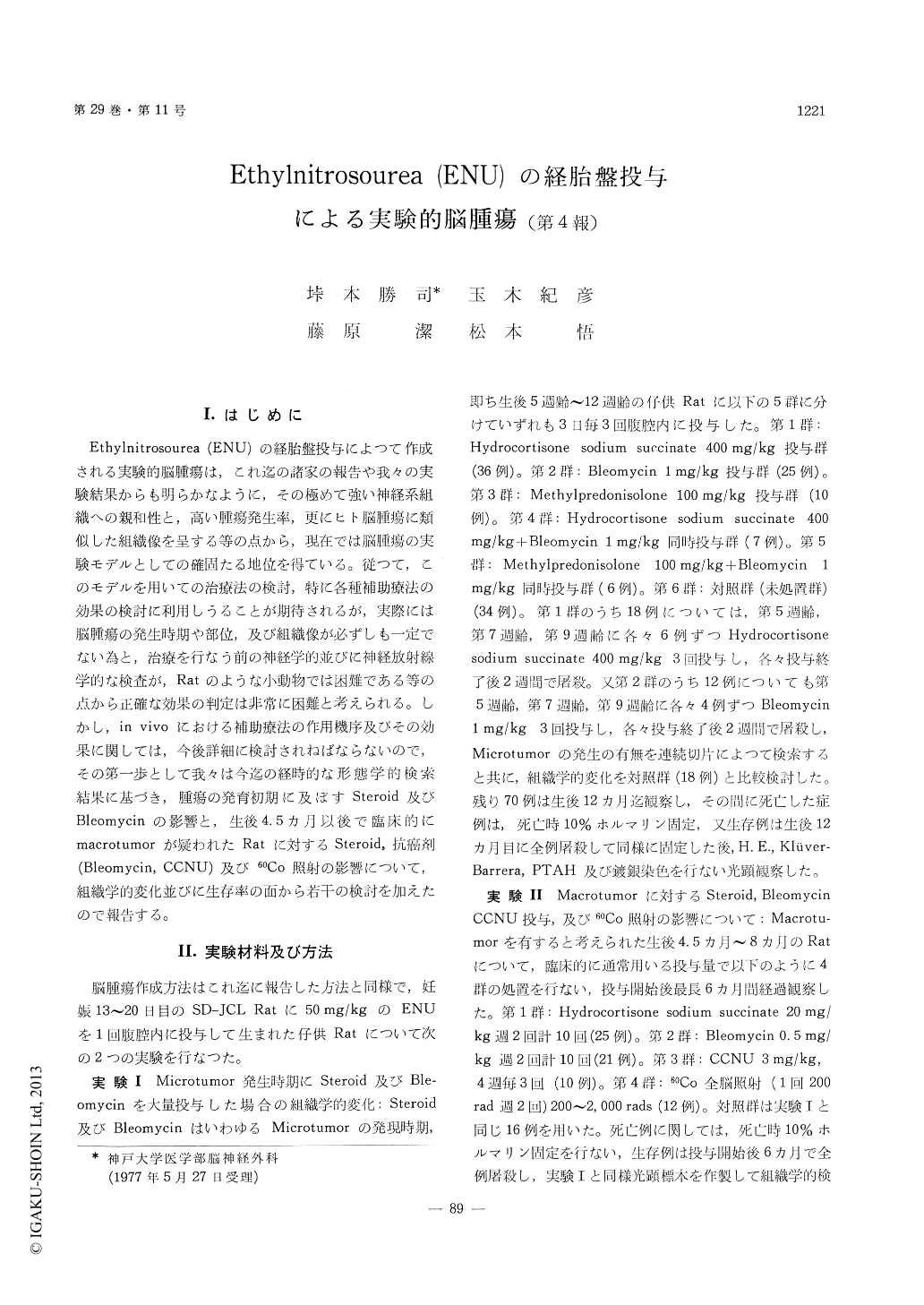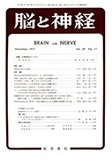Japanese
English
- 有料閲覧
- Abstract 文献概要
- 1ページ目 Look Inside
I.はじめに
Ethylnitrosourea (ENU)の経胎盤投与によつて作成される実験的脳腫瘍は,これ迄の諸家の報告や我々の実験結果からも明らかなように,その極めて強い神経系組織への親和性と,高い腫瘍発生率,更にヒト脳腫瘍に類似した組織像を呈する等の点から,現在では脳腫瘍の実験モデルとしての確固たる地位を得ている。従つて,このモデルを用いての治療法の検討,特に各種補助療法の効果の検討に利用しうることが期待されるが,実際には脳腫瘍の発生時期や部位,及び組織像が必ずしも一定でない為と,治療を行なう前の神経学的並びに神経放射線学的な検査が,Ratのような小動物では困難である等の点から正確な効果の判定は非常に困難と考えられる。しかし,in vivoにおける補助療法の作用機序及びその効果に関しては,今後詳細に検討されねばならないので,その第一歩として我々は今迄の経時的な形態学的検索結果に基づき,腫瘍の発育初期に及ぼすSteroid及びBleomycinの影響と,生後4.5カ月以後で臨床的にmacrotumorが疑われたRatに対するSteroid,抗癌剤(Bleomycin,CCNU)及び60Co照射の影響について,組織学的変化並びに生存率の面から若干の検討を加えたので報告する。
Therapeutic effects of some steroids and anti-cancer agents to experimental brain tumors pro-duced transplacentally by Ethylnitrosourea in SD-JCL rats were investigated from the survival andhistological points of view.
In the first experiment, the effects of largeamounts of Steroids (Hydrocortisone sodium suc-cinate 400mg/kg×3, and Methylpredonisolone 100mg/kg×3) and Bleomycin (1mg/kg×3) were ex-amined in 118 rats between the age of 5 and 12weeks, which corresponded to the stage of thedevelopment of microtumors.
No microtumors but remarkable histologicalchanges such as enlarged ventricles or atrophy ofbrains were found in the group of rats treated withlarge amount of Steroids. On the other hand, onemicrotumor and minimal histological changes werenoticed in the group of rats treated with Bleomycin.In addition, a follow up study for one year aftertreatment revealed that these treatments had someinhibitory effect to the development of the braintumors, or delayed them.
After one year treatment with each drug, thesurvival rate of treated rats increased. But, nosignificant difference in the survival rate wasnoticed between single treatment and combinedtherapy groups.
In the second experiment, the effect of a commonvolume of Steroids, Bleomycin and CCNU admin-istration as well as 60Co whole brain irradiationwas investigated in 68 rats with macrotumors after4.5 months of age. Each survival rate of groupsof rats treated with either steroid (Hydrocortisonesodium succinate 20mg/kg×10), Bleomycin (0.5mg/kg×10) or CCNU (3mg/kg×3) was remarkablyhigher than untreated rats 6th months after thetreatment. However, the survival rate of the ratstreated with 60Co whole brain irradiation wassimilar to the control rats. One of the causes ofthe poor result of irradiation seemed to be due tothe acute injury of the brain through failure oftechnique.
Histological examination revealed a small hemor-rhage or localized necrosis in the group of 60Cowhole brain irradiation, which differed from allother groups.

Copyright © 1977, Igaku-Shoin Ltd. All rights reserved.


